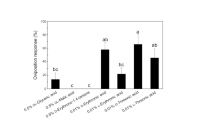Abstract
Oviposition stimulants of an Aristolochiaceae-feeding swallowtail butterfly,Atrophaneura alcinous, were isolated from the leaves ofAristolochla debilis and characterized as a mixture of aristolochic acids and sequoyitol. An artificial blend of these components applied to filter paper induced a significant oviposition response by the female butterflies, identical to that elicited by intact leaves of theAristolochia host plant.
Similar content being viewed by others
References
Anderson, A.B., Riffer, R., andWong, A. 1968. Chemistry of the genusSequoia. V. Cyclitols from the heartwood ofSequoia gigantea.Phytochemistry 7:1367–1371.
Binder, R.G., andHaddon, W.F. 1984. Cyclitols of soybean leaves.J. Agric. Food Chem. 32:685–687.
Chen, Z.H., Huang, B.S., Zhu, D.Y., andYin, M.L. 1981. Studies on the active principles ofAristolochia debilis. II. 7-Hydroxyaristolochic acid-A and 7-methoxyaristolochic acid-A.Hua Hsueh Hsueh Pao 39:239–242.
Cranswick, A.M., andZabkiewicz, J.A. 1979. Quantitative analysis of monosaccharides, cyclitols sucrose, quinic and shikimic acids inPinus radiata extracts on a glass support-coated open tubular capillary column by automated gas chromatography.J. Chromatogr. 171:233–242.
Ehrlich, P.R., andRaven, P.H. 1964. Butterflies and plants: A study in coevolution,Evolution 18:586–608.
Feeny, P.P. 1987. The roles of plant chemistry in association between swallowtail butterflies and their host plants, pp. 353–359,in V. Labeyrie, G. Fabres, and D. Lachaise (eds.). Insects-Plants. Dr. W. Junk Publishers, Dordrecht.
Feeny, P., Rosenberry, L., andCarter, M. 1983. Chemical aspects of oviposition behavior in butterflies, pp. 27–76,in S. Ahmad (ed.). Herbivorous Insects: Host-Seeking Behavior and Mechanisms. Academic Press, New York.
Honda, K. 1986. Flavanone glycosides as oviposition stimulants in papilionid butterfly,Papilio protenor.J. Chem. Ecol. 12:1999–2010.
Ichinosé, T., andHonda, H. 1978. Ovipositional behavior ofPapilioprotenor demetrius Cramer and the factors involved in its host plants.Appl. Entomol. Zool. 13:103–114.
Mix, D.B., Guinaudeau, H., andShamma, M. 1983. The aristolochic acids and aristolactums.J. Nat. Prod. 45:657–666.
Murakami, T., Wada, H., Tanaka, N., Kuraishi, T., Sakai, Y., andChen, C.M. 1985. Chemical and chemotaxonomical studies on filices. LVI. Studies on the constituents of the deval-liaceous fems (1).Yakugaku Zasshi 105:649–654.
Nishida, R. 1977. Oviposition stimulants of some papilionid butterflies contained in their host plants.Botyu-Kagaku 42:133–140.
Nishida, R., andFukami, H. 1989. Ecological adaptation of an Aristolochiaceae-feeding swallowtail butterfly,Atrophaneura alcinous, to Aristolocic acids.J. Chem. Ecol. 15:2549–2563.
Nishida, R., Ohsugi, T., Kokubo, S., andFukami, H. 1987. Oviposition stimulants of aCitrus-feeding swallowtail butterfly,Papilio xuthus L.Experientia 43:342–344.
Ohmoto, T., Yoshida, O., Kano, M., andIkuse, M. 1979. Constituents of pollen. VII. Constituents ofGinkgo biloba L.Shoyakugaku Zasshi 34:145–150.
Ohsugi, T., Nishida, R., andFukami, H. 1985. Oviposition stimulant ofPapilio xuthus, aCitrus-feeding swallowtail butterfly.Agric. Biol. Chem. 49:1897–1900.
Rausher, M.D. 1978. Search image for leaf shape in a butterfly.Science 200:1071–1073.
Sato, A., Senda, M., Kakutani, T., Watanabe, Y., andKitao, K. 1966. Studies on Wood phenolics (II). Extractives from heartwood ofMetaseguoia glyptostrobides Hu et Cheng.Wood Res. 39:13–21.
Saxena, K.L., andGoyal, S. 1978. Host-plant relations of the citrus butterfly,Papilio demoleus L.: Orientational and Ovipositional responses.Entomol. Exp. Appl. 24:1–10.
Tomita, M., andSasagawa, S. 1959. Studies on the ingredients of aristolochiaceous plants. III. The ingredients ofAristolochia debilis Sieb, et Zucc. and of the Chinese drug “Fang-chi” in Formosa.Yakugaku Zasshi 79:1470–1479.
Vaidya, V.G. 1969. Investigations of the role of visual stimuli in the egg-laying and resting behavior ofPapilio demoleus L. (Papilionidae, Lepidoptera).Anim. Behav. 17:350–355.
Author information
Authors and Affiliations
Rights and permissions
About this article
Cite this article
Nishida, R., Fukami, H. Oviposition stimulants of an Aristolochiaceae-feeding swallowtail butterfly,Atrophaneura alcinous . J Chem Ecol 15, 2565–2575 (1989). https://doi.org/10.1007/BF01014732
Received:
Accepted:
Issue Date:
DOI: https://doi.org/10.1007/BF01014732




